英语肯定句变否定句的基本方法
- 格式:doc
- 大小:36.00 KB
- 文档页数:2

一、首先,要看肯定句中是否有情态动词,如果有情态动词,直接在情态动词后面加not即可,同时句中如果有some,some就要变成any。
举例如下:1、肯定句:Mike can help you solve the problem.译文:迈克可以帮你解决那个问题。
否定句:Mike can't help you solve the problem. (can't=can not)译文:迈克不能帮你解决那个问题。
2、肯定句:You should lend some money to Mary.译文:你应该借给玛丽一些钱。
否定句:You shouldn't lend any money to Mary. (shouldn't=should not)译文:你不应该借钱给玛丽。
二、如果肯定句中没有情态动词,那就要看句中有无be动词的相应形式,如果有,直接在be动词后面加not,句中有some,some变any。
举例如下:1、肯定句:I am an English teacher.译文:我是一名英语老师。
否定句:I‘m not an English teacher.译文:我不是一名英语老师。
2、肯定句:There are some books on the desk.译文:书桌上有一些书。
否定句:There aren't any books on the desk.译文:书桌上没有书。
三、如果肯定句中既没有情态动词,也没有be动词,那么就要用相应的助动词加上not来变换,句中有some,some变any。
举例如下:1、肯定句:She likes helping others.译文:她喜欢帮助别人。
否定句:She doesn't like helping others.译文:她不喜欢帮助别人。
2、肯定句:They have some apples.译文:他们有一些苹果。
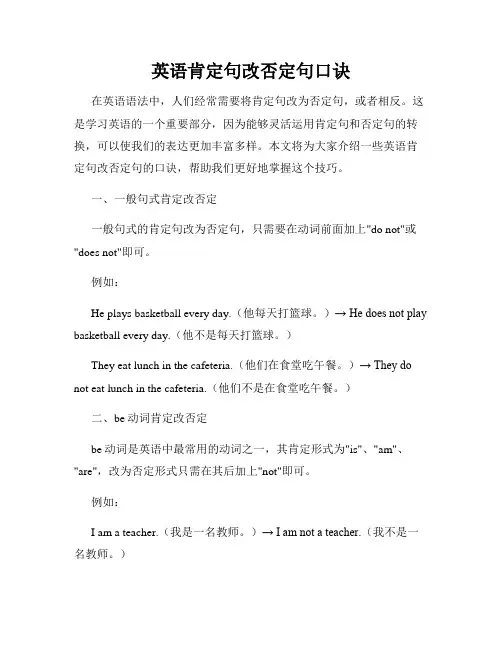
英语肯定句改否定句口诀在英语语法中,人们经常需要将肯定句改为否定句,或者相反。
这是学习英语的一个重要部分,因为能够灵活运用肯定句和否定句的转换,可以使我们的表达更加丰富多样。
本文将为大家介绍一些英语肯定句改否定句的口诀,帮助我们更好地掌握这个技巧。
一、一般句式肯定改否定一般句式的肯定句改为否定句,只需要在动词前面加上"do not"或"does not"即可。
例如:He plays basketball every day.(他每天打篮球。
)→ He does not play basketball every day.(他不是每天打篮球。
)They eat lunch in the cafeteria.(他们在食堂吃午餐。
)→ They do not eat lunch in the cafeteria.(他们不是在食堂吃午餐。
)二、be动词肯定改否定be动词是英语中最常用的动词之一,其肯定形式为"is"、"am"、"are",改为否定形式只需在其后加上"not"即可。
例如:I am a teacher.(我是一名教师。
)→ I am not a teacher.(我不是一名教师。
)They are students.(他们是学生。
)→ They are not students.(他们不是学生。
)三、情态动词肯定改否定情态动词在英语中也占有重要地位,它们有自己的肯定形式和否定形式。
要将肯定形式转化为否定形式,只需在情态动词后面加上"not"即可。
例如:She can swim very well.(她会游泳得很好。
)→ She cannot swim very well.(她游泳不很好。
)You should listen to your parents.(你应该听父母的话。
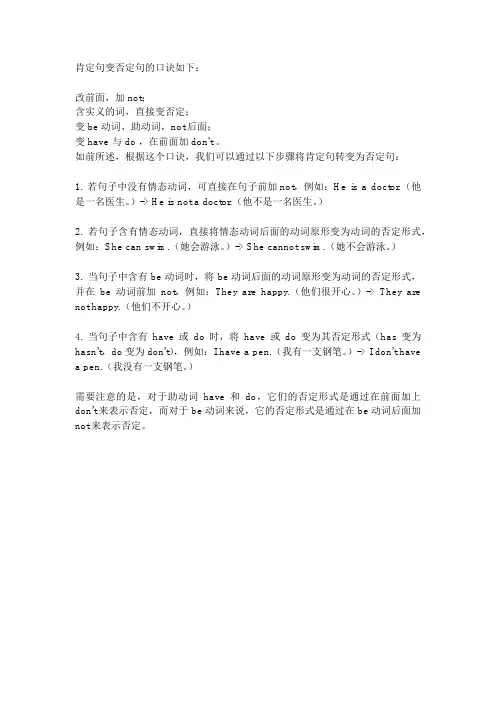
肯定句变否定句的口诀如下:
改前面,加not;
含实义的词,直接变否定;
变be动词、助动词,not后面;
变have 与 do ,在前面加don't 。
如前所述,根据这个口诀,我们可以通过以下步骤将肯定句转变为否定句:
1. 若句子中没有情态动词,可直接在句子前加not,例如:He is a doctor.(他是一名医生。
)-> He is not a doctor.(他不是一名医生。
)
2. 若句子含有情态动词,直接将情态动词后面的动词原形变为动词的否定形式,例如:She can swim.(她会游泳。
)-> She cannot swim.(她不会游泳。
)
3. 当句子中含有be动词时,将be动词后面的动词原形变为动词的否定形式,并在be动词前加not,例如:They are happy.(他们很开心。
)-> They are not happy.(他们不开心。
)
4. 当句子中含有have或do时,将have或do变为其否定形式(has变为hasn't,do变为don't),例如:I have a pen.(我有一支钢笔。
)-> I don't have a pen.(我没有一支钢笔。
)
需要注意的是,对于助动词have和do,它们的否定形式是通过在前面加上don't来表示否定,而对于be动词来说,它的否定形式是通过在be动词后面加not来表示否定。
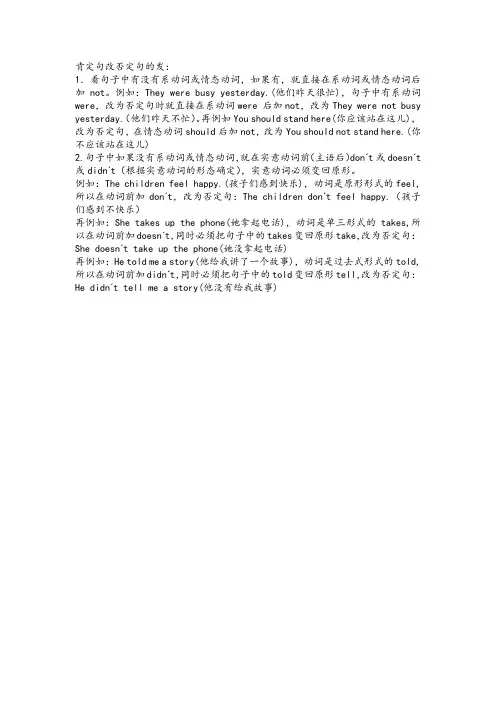
肯定句改否定句的发:
1.看句子中有没有系动词或情态动词,如果有,就直接在系动词或情态动词后加not。
例如:They were busy yesterday.(他们昨天很忙),句子中有系动词were,改为否定句时就直接在系动词were 后加not,改为They were not busy yesterday.(他们昨天不忙)。
再例如You should stand here(你应该站在这儿),改为否定句,在情态动词should后加not,改为You should not stand here.(你不应该站在这儿)
2.句子中如果没有系动词或情态动词,就在实意动词前(主语后)don´t或doesn´t 或didn´t(根据实意动词的形态确定),实意动词必须变回原形。
例如:The children feel happy.(孩子们感到快乐),动词是原形形式的feel,所以在动词前加don´t,改为否定句:The children don´t feel happy.(孩子们感到不快乐)
再例如:She takes up the phone(她拿起电话),动词是单三形式的takes,所以在动词前加doesn´t,同时必须把句子中的takes变回原形take,改为否定句:She doesn´t take up the phone(她没拿起电话)
再例如:He told me a story(他给我讲了一个故事),动词是过去式形式的told,所以在动词前加didn´t,同时必须把句子中的told变回原形tell,改为否定句:He didn´t tell me a story(他没有给我故事)。
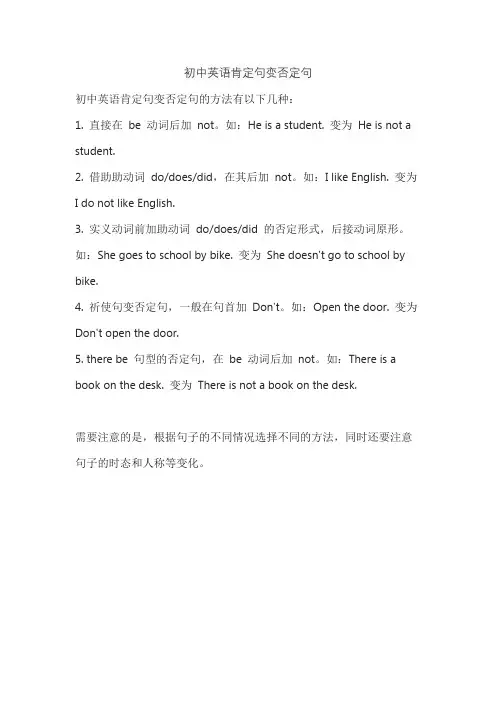
初中英语肯定句变否定句
初中英语肯定句变否定句的方法有以下几种:
1. 直接在be 动词后加not。
如:He is a student. 变为He is not a student.
2. 借助助动词do/does/did,在其后加not。
如:I like English. 变为
I do not like English.
3. 实义动词前加助动词do/does/did 的否定形式,后接动词原形。
如:She goes to school by bike. 变为She doesn't go to school by bike.
4. 祈使句变否定句,一般在句首加Don't。
如:Open the door. 变为Don't open the door.
5. there be 句型的否定句,在be 动词后加not。
如:There is a book on the desk. 变为There is not a book on the desk.
需要注意的是,根据句子的不同情况选择不同的方法,同时还要注意句子的时态和人称等变化。

肯定句变否定句的基本方法一、动词be 的否定式动词be根据不同的人称和时态可以有am, is, are, was, were等不同形式,可用作连系动词(表示“是”、“在”等)和助动词(用于构成进行时态和被动语态等),但不管何种情况,构成否定式时,一律在其后加notI’m old, but you’re young. 我老了,但你还年轻。
→I’m not old, but you’re not young. 我还不老,但你不年轻了。
He was reading and I was writing. 他在读,我在写。
→He was not reading and I was not writing. 他没有在读,我没有在写。
二、动词have 的否定式动词have根据不同的人称和时态可以有have, has, had等形式,可以用作实意动词和助动词,分以下情况讨论1. 用作实意动词表示状态,如表示拥有、患病或用于have to表示“必须”等,在构成否定式时可以直接在其后加not,也可根据情况在其前使用don’t, doesn’t, didn’tHe has a car. 他有辆小汽车。
→He hasn’t a car. / He doesn’t have a car. 他没有小汽车。
He had some dictionaries. 他有一些词典。
→He hadn’t any dictionaries. / He didn’t have any dictionaries. 他没有词典。
You have to go with him. 你必须同他一起去。
→You haven’t to go with him. / You don’t have to go w ith him. 你不必同他一起去。
【注】have to构成否定式时以在其前加don’t等较为常见。
2. 用作实意动词表示动作,如表示“吃(=eat)”、“喝(=drink)”、“拿(=take)”、“收到(=receive)”、“度过(=spend)”等,构成否定式时不能直接在其后加not,而应根据情况在其前使用don’t, doesn’t, didn’tHe had some cake for breakfast. 他早餐吃了些蛋糕。
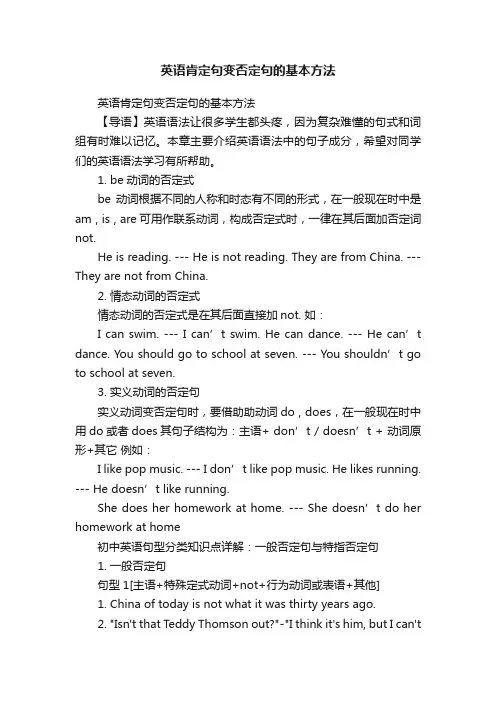
英语肯定句变否定句的基本方法英语肯定句变否定句的基本方法【导语】英语语法让很多学生都头疼,因为复杂难懂的句式和词组有时难以记忆。
本章主要介绍英语语法中的句子成分,希望对同学们的英语语法学习有所帮助。
1. be动词的否定式be 动词根据不同的人称和时态有不同的形式,在一般现在时中是am , is , are可用作联系动词,构成否定式时,一律在其后面加否定词not.He is reading. --- He is not reading. They are from China. --- They are not from China.2. 情态动词的否定式情态动词的否定式是在其后面直接加not. 如:I can swim. --- I can’t swim. He can dance. --- He can’t dance. You should go to school at seven. --- You shouldn’t go to school at seven.3. 实义动词的否定句实义动词变否定句时,要借助助动词do , does,在一般现在时中用do或者does其句子结构为:主语+ don’t / doesn’t + 动词原形+其它例如:I like pop music. --- I don’t like pop music. He likes running. --- He doesn’t like running.She does her homework at home. --- She doesn’t do her homework at home初中英语句型分类知识点详解:一般否定句与特指否定句1. 一般否定句句型1[主语+特殊定式动词+not+行为动词或表语+其他]1. China of today is not what it was thirty years ago.2. "Isn't that Teddy Thomson out?"-"I think it's him, but I can'tbe a hundred percent sure."3. "Oh, sir, he can't have said such a thing! He can't have spoken like that to you, sir!"4. We must not wait for favors from Nature; we must take them from her.5. I haven't finished the book yet.6. Money could not buy happiness.[注1] He is no fool. Great barkers are no biters.[注2] 二十四个特殊定式动词:句型2[主语+do(does, did)+ not+行为动词+其他]1. Sorrow doesn't buy bread.2. Pure gold does not dread fire.3. "Why is Mr. Cooper so angry today?"-"I don't know why."4. "They did not steal so much."-"I don't care how much." He said, "… A thief is a thief."句型3[主语+ 行为动词+ no/not+宾语+其他]1. A rolling stone gathers no moss.2. Viola, hearing this, knew not how to behave, nor how to answer her.3. I know not what course others may take, but, as for me, give me liberty or give me death!4. We are fleet-winged men at arms; we fear not mountains high or rivers deep.句型4[There be+ no/not/not any+主语(+状语)]1. There was no well in the village at that time.2. Oliver Twist was born in a workhouse… There were no aunts, no sisters, no cousins, no grand mothers.3. There is not a moment to be lost.4. There is no holding back the wheel of history[附注] 一般否定句的其他表达方式:1. Who knows it? (=No one knows it.) Dare he do it? (=Hedare not do it.)2. God only knows! (=No one knows.) As if I would allow it! (= I would certainly not allow it.)3. Catch me doing that!4. If I do I am a villain. (=I will not do.) Do that again if you dare.5. In Heaven, an angel is nobody in particular. They shun personal fame and gains.6. The city and the areas around it are an ice-free port and a nuclear weapon-free zone. The building is in a state of neglect.7. She stood still, trying winly (in vain) to answer the battery of questions raised by the reporters.8. I dislike the idea very much. Mr. White has refrained from making any official comment on the coup in that country. Yesterday she failed to get to school on time. The evidence is conclusive, excluding all possibilities of doubt. They excluded children (from) getting in. We'll forever live up to what the party expects of us. Avoid operating the keys roughly. She was refused admittance by them.9. Slips are scarcely avoidable when you're new to your work. He is ignorant of conditions at the levels. Our PLA is worthy of being called a great army pf the people.10. The meetings were marked by such an absence of lively discussions that at times they were almost on the point of breaking up. Lei Feng's noble deeds are above all praise. To do this is beyond my ability. He is out of the office. (= He is not in the office.) Tom is away from Cambridge. (= Tom is not at Cambridge.) It is far from perfect. That served to strengthen instead of weaken our determination (or: That strengthened, rather than weakened, our determination.) The truth is quiteother than what you think. I know better than to quarrel.2. 特指否定句句型5[…not+非谓语成分…]1. Not a soul was anywhere visible.2. You must always remember not to become conceited.3. The teacher told his pupils not to make such a mistake again.4. I went to see him off, not to meet him.5. We felt sorry for not coming on time句型6[主语+否定式谓语+(宾语)+状语或从句(被否定部分)]1. I don't think it is right to make such hasty decision.2. I'm not feeling very well today.3. I don't believe that he will come tomorrow.4. You can't judge a thing only by its looks.5. He's studying English now, but he doesn't speak English very well yet.6. People did not shake off colonialist's yoke in order to put on hegemonist's yoke.7. Don't think ill of me because I use her help. She gives it cheerfully as you see…返回:初中英语句型分类知识点详解初中英语句型分类知识点详解:部分否定句与全体否定句部分否定句句型7[All, every等总括词…not+谓语动词…]1. All is not gold that glitters.2. All is not lost that is in peril.3. And yet all did not go smoothly between them, for the younger man…had his heart set on New York.4. I don't like both of the novels.5. Every one cannot make music.6. Everybody, it is true, wouldn't like it.7. Such a thing is notfound everywhere.8. The good and the beautiful do not always go together.9. A man of learning is not always a man of wisdom. 10. I don't wholly agree.[注] Some people like that sort of thing; Some don't.全体否定句句型8[no, none等否定词…+肯定式谓语+其他]1. Everybody talks about the weather, but nobody does anything about it.2. No trickery can fool us.3. None of my friends smoke.4. I could remember neither the name of the author nor the title of the book.5. Nothing in the world is difficult for one who sets his mind to it.6. The book was nowhere to be found.7. Neither of the sisters is here.8. Never have we been daunted by difficulties.句型9[主语+否定式谓语+不定代词或不定副词]1. I do not know any of them.2. I did not receive any letters yesterday.3. I don't like either of the novels.4. Justice must not be denied to anyone.5. Did you go any where yesterday?-No, I didn't go anywhere yesterday.6. Anyhow I shall not go today.[注] 不可说 "anybody cannot do it." 只能说 "nobody can do it."句型10[All等概括词+肯定式谓语+含否定意义的单词…]1. All germs are invisible to the naked eye.2. All his plans came to nothing.3. Both visitors are unwelcome.4. Every plan made by him is impossible of execution.5. We all disbelieve in the existence of God.6. Their quarrels are always interminable.返回:初中英语句型分类知识点详解初中英语句型分类知识点详解:延续否定句与半否定句延续否定句句型11[(前句)否定句,+(后句)否定句]1. "Oh, no, no, no and again no," said Pinocchio. "I must bea good boy."2. "Am I troubling you?"-"no, not in the least."3. I shall never do it, not under any circumstances.4. We must not think of him as a big, strong boy. Far from it!5. I don't know how much you've got, and I dare say you hardly know yourself, as it would take a pretty long time to count it.句型12[(前句) 主语+否定式谓语…,( 后句)not+ (同前)主语]1. I'll not do such a thing, not I.2. He will not break his word, not he.3. They will not be discouraged, not they.4. Tom cannot speak Russian, not he.句型13[(前句) 否定句,+ ( 后句)not/neither]1. Frieda didn't go to the dance, neither did Fanny.2. You can't do it, nor can anybody else.3. You did not see him, neither did I.4. Are you not going? Neither am I.5. Oliver did not come that day, nor the next day; nor the next after that, nor for many, many days after.6. I know not what, nor where, neither what latitude, what country, what nation, or what river. I neither saw, nor desired tosee any people; the principal thing I wanted was fresh water.[注1] 有时根据意义上的需要,下列句子是允许的。
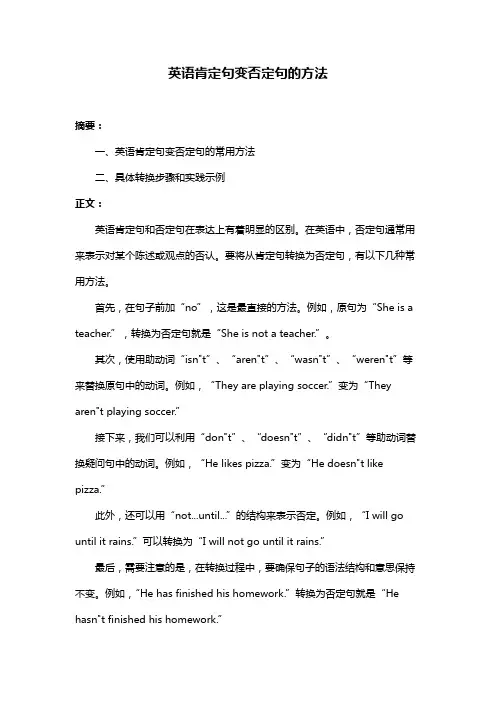
英语肯定句变否定句的方法摘要:一、英语肯定句变否定句的常用方法二、具体转换步骤和实践示例正文:英语肯定句和否定句在表达上有着明显的区别。
在英语中,否定句通常用来表示对某个陈述或观点的否认。
要将从肯定句转换为否定句,有以下几种常用方法。
首先,在句子前加“no”,这是最直接的方法。
例如,原句为“She is a teacher.”,转换为否定句就是“She is not a teacher.”。
其次,使用助动词“isn"t”、“aren"t”、“wasn"t”、“weren"t”等来替换原句中的动词。
例如,“They are playing soccer.”变为“They aren"t playing soccer.”接下来,我们可以利用“don"t”、“doesn"t”、“didn"t”等助动词替换疑问句中的动词。
例如,“He likes pizza.”变为“He doesn"t like pizza.”此外,还可以用“not...until...”的结构来表示否定。
例如,“I will go until it rains.”可以转换为“I will not go until it rains.”最后,需要注意的是,在转换过程中,要确保句子的语法结构和意思保持不变。
例如,“He has finished his homework.”转换为否定句就是“He hasn"t finished his homework.”总之,掌握以上方法,就可以轻松地将英语肯定句转换为否定句。
在实际应用中,根据不同的语境和句子结构,选择合适的方法进行转换,使句子更加丰富和生动。
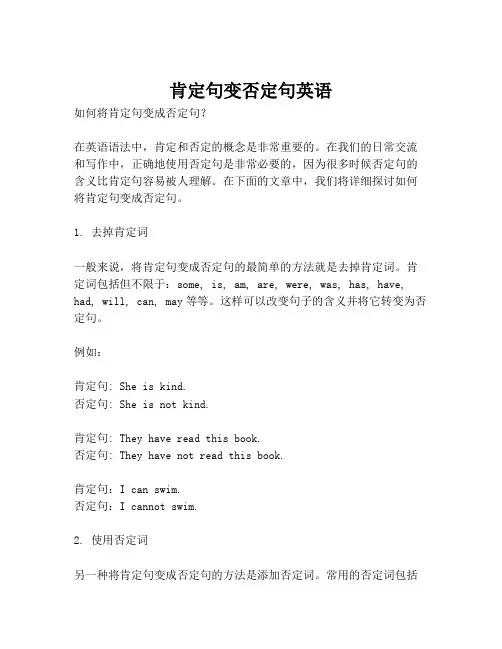
肯定句变否定句英语如何将肯定句变成否定句?在英语语法中,肯定和否定的概念是非常重要的。
在我们的日常交流和写作中,正确地使用否定句是非常必要的,因为很多时候否定句的含义比肯定句容易被人理解。
在下面的文章中,我们将详细探讨如何将肯定句变成否定句。
1. 去掉肯定词一般来说,将肯定句变成否定句的最简单的方法就是去掉肯定词。
肯定词包括但不限于:some, is, am, are, were, was, has, have, had, will, can, may等等。
这样可以改变句子的含义并将它转变为否定句。
例如:肯定句: She is kind.否定句: She is not kind.肯定句: They have read this book.否定句: They have not read this book.肯定句:I can swim.否定句:I cannot swim.2. 使用否定词另一种将肯定句变成否定句的方法是添加否定词。
常用的否定词包括但不限于:no, not, never, nothing, neither等等。
使用这些否定词能给句子带来否定的意义。
例如:肯定句: He asked me something.否定句: He didn’t ask me anything.肯定句: He always comes late.否定句: He never comes early.肯定句: I like coffee.否定句: I don’t like coffee.3. 使用相反的形容词或副词在有些情况下,我们可以使用相反的形容词或副词来将肯定句变成否定句。
例如,将“happy”换成“unhappy”,将“fast”换成“slow”等等。
例如:肯定句:She is beautiful.否定句:She is not ugly.肯定句:He is tall.否定句:He is not short.肯定句:He runs fast.否定句:He does not run slowly.总之,在英语语法中,正确使用肯定句和否定句非常重要。
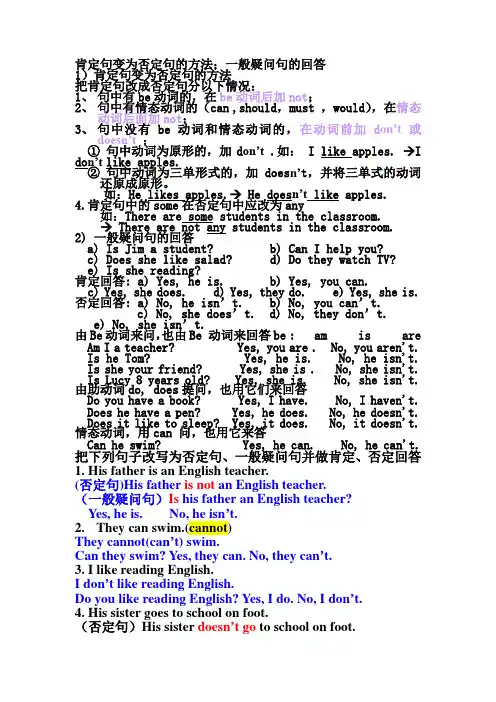
肯定句变为否定句的方法;一般疑问句的回答1)肯定句变为否定句的方法把肯定句改成否定句分以下情况:1、句中有be动词的,在be动词后加not;2、句中有情态动词的(can ,should,must ,would),在情态动词后面加not;3、句中没有be动词和情态动词的,在动词前加d on’t或doesn’t;①句中动词为原形的,加d on’t.如: I like apples. →Ido n’t like apples.②句中动词为三单形式的,加does n’t,并将三单式的动词还原成原形。
如:He likes apples.→ He does n’t like apples.4.肯定句中的some在否定句中应改为any如:There are some students in the classroom.→ There are not any students in the classroom.2) 一般疑问句的回答a) Is Jim a student? b) Can I help you?c) Does she like salad? d) Do they watch TV?e) Is she reading?肯定回答: a) Yes, he is. b) Yes, you can.c) Yes, she does. d) Yes, they do. e) Yes, she is.否定回答: a) No, he isn’t. b) No, you can’t.c) No, she does’t. d) No, they don’t.e) No, she isn’t.由Be动词来问,也由Be 动词来回答be : am is areAm I a teacher? Yes, you are . No, you aren't.Is he Tom? Yes, he is. No, he isn't.Is she your friend? Yes, she is . No, she isn't.Is Lucy 8 years old? Yes, she is. No, she isn't.由助动词do, does提问,也用它们来回答Do you have a book? Yes, I have. No, I haven't. Does he have a pen? Yes, he does. No, he doesn't. Does it like to sleep? Yes, it does. No, it doesn't.情态动词,用can 问,也用它来答Can he swim? Yes, he can. No, he can't. 把下列句子改写为否定句、一般疑问句并做肯定、否定回答1. His father is an English teacher.(否定句)His father is not an English teacher.(一般疑问句)Is his father an English teacher?Yes, he is. No, he isn’t.2. They can swim.(cannot)They cannot(can’t) swim.Can they swim? Yes, they can. No, they can’t.3. I like reading English.I don’t like reading English.Do you like reading English? Yes, I do. No, I don’t.4. His sister goes to school on foot.(否定句)His sister doesn’t go to school on foot.(一般疑问句)Does his sister go to school on foot? Yes, she does. No, she doesn’t.5. Mrs Li and Kitty watch TV at night.Mrs Li and Kitty don’t watch TV at night.Do Mrs Li and Kitty watch TV at night?Yes, they do. No, they don’t.6. I do my homework after school.I don’t do my homework after school.Do you do your homework after school?Yes, I do. No, I don’t.课后练习把下列句子改写为否定句、一般疑问句及肯定、否定回答1. The boy does some housework at home.2. We are from China.3. Jim has some books.4. I have a football book.5. My aunt often watches TV.6. My parents can play ping-pong.7. They are my grandparents.8. Gina wants a cup of coffeeAre you a student? Are you students? Does he look cool?Can she draw? Can they dance?。
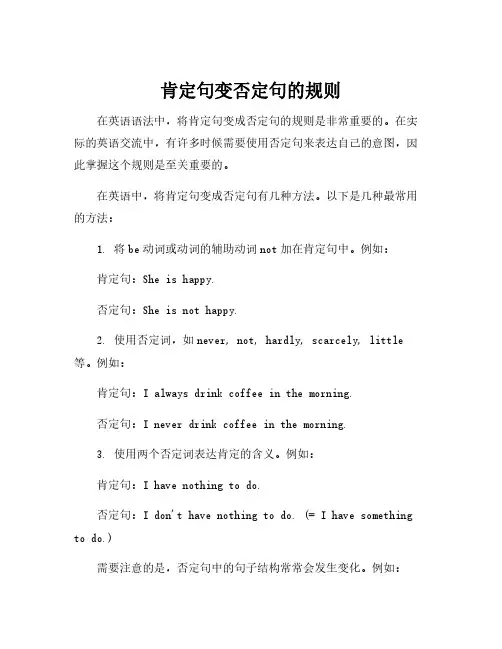
肯定句变否定句的规则在英语语法中,将肯定句变成否定句的规则是非常重要的。
在实际的英语交流中,有许多时候需要使用否定句来表达自己的意图,因此掌握这个规则是至关重要的。
在英语中,将肯定句变成否定句有几种方法。
以下是几种最常用的方法:1.将be动词或动词的辅助动词not加在肯定句中。
例如:肯定句:She is happy.否定句:She is not happy.2.使用否定词,如never,not,hardly,scarcely,little 等。
例如:肯定句:I always drink coffee in the morning.否定句:I never drink coffee in the morning.3.使用两个否定词表达肯定的含义。
例如:肯定句:I have nothing to do.否定句:I don't have nothing to do.(=I have something to do.)需要注意的是,否定句中的句子结构常常会发生变化。
例如:肯定句:He speaks English well.否定句:He does not speak English well.在这个例子中,主语和动词之间插入了动词的辅助动词does。
这是因为在一般现在时和一般过去时中,要使用动词的辅助动词来表示否定意义。
此外,某些词语的否定形式也要格外留意。
例如:肯定句:I have some money.否定句:I have no money.肯定句:There is a book on the desk.否定句:There is no book on the desk.总之,在学习英语语法时,将肯定句变成否定句的规则是必不可少的一部分。
只有熟练地掌握了这些规则,才能在实际的英语交流中更自如地表达自己的意图。
一、肯定句改否定句的方法:1、在be动词后加not。
如:is not , are not ,am not, was not, were not;2、在can,should, will等后加not。
如:cannot,should not, will not;3、上述都没有的,在动词前加助动词否定形式don’t/doesn’t/didn’t。
4、 some 改成any。
如: I am a girl. → I am not a girl.You are a student. →You are not a student.→You aren’t a student.This is Tom’s bag, → This is not Tom’s bag.→ This isn’t Tom’s bag.答题方法是;否定词not在be后边。
二、肯定句改一般疑问句的方法:1、把be动词放在句首,剩下的照抄,(some 改成any,I改成you,my改成your,)句点改成问号。
2、把can,shall, will等放到句首,剩下的照抄,(some 改成any,I改成you,my改成your,)句点改成问号。
3、上述都没有的,在句首请助动词Do/Does/Did帮忙,剩下的照抄,(some 改成any,I改成you,my 改成your,)句点改成问号。
注意:句首的第一个字母要大写,句尾标点应为“?”。
如:I am in Class 6. →Are you in Class 6?You are from America. →Are you from America? It is an orange. →Is it an orange?答题方法是:要想提问,be提前,句末“?”别忘了。
4、就一般疑问句回答一般疑问句有两种回答,即:肯定回答和否定回答。
其中,肯定回答用yes,否定回答用no。
语句顺序为:Yes + 主语+ am /is/ are/was/were.|can.|do/does/did|; No + 主语+ am not/ isn’t/ aren’t/wasn't/weren't.|can't.|don't/doesn't/didn't |.。
英语肯定句改为否定句的方法
将英语肯定句改为否定句,需要遵循以下步骤:
1. 找到句中的动词。
2. 如果动词是be动词(即am, is, are),直接在其后加not。
3. 如果动词是助动词(即do, does, did),在其后加not。
4. 如果动词是实意动词,则需要借助助动词do, does, did,在其后加not。
5. 如果有情态动词(如must, can等),则在情态动词后加not。
6. 如果有否定词如never、no等,则不需要再加否定词。
7. 如果有already、yet等副词,需要变为yet或still。
8. 如果有some,需要变为any。
以下是一些具体的例子:
1. 肯定句:I am a student.
否定句:I am not a student.
2. 肯定句:She does her homework every day.
否定句:She doesn't do her homework every day.
3. 肯定句:He has a cat.
否定句:He doesn't have a cat.
4. 肯定句:They will come here.
否定句:They won't come here.
5. 肯定句:We must finish our work today. 否定句:We must not finish our work today.。
肯定句变否定句的基本方法一、动词be 的否定式动词be根据不同的人称和时态可以有am, is, are, was,were等不同形式,可用作连系动词(表示“是"、“在”等)和助动词(用于构成进行时态和被动语态等),但不管何种情况,构成否定式时,一律在其后加notI’m old,but you’re young. 我老了,但你还年轻。
→I'm not old,but you're not young. 我还不老,但你不年轻了。
He was reading and I was writing。
他在读,我在写.→He was not reading and I was not writing。
他没有在读,我没有在写。
二、动词have 的否定式动词have根据不同的人称和时态可以有have,has,had等形式,可以用作实意动词和助动词,分以下情况讨论1. 用作实意动词表示状态,如表示拥有、患病或用于have to表示“必须”等,在构成否定式时可以直接在其后加not,也可根据情况在其前使用don’t, doesn't, didn’tHe has a car. 他有辆小汽车。
→He hasn’t a car. / He doesn’t have a car. 他没有小汽车.He had some dictionaries. 他有一些词典。
→He hadn’t any dictionaries。
/ He didn’t have any dictionaries。
他没有词典。
You have to go with him。
你必须同他一起去。
→You haven’t to go with him. / You don’t have to go w ith him. 你不必同他一起去. 【注】have to构成否定式时以在其前加don’t等较为常见。
2. 用作实意动词表示动作,如表示“吃(=eat)”、“喝(=drink)”、“拿(=take)”、“收到(=receive)"、“度过(=spend)"等,构成否定式时不能直接在其后加not,而应根据情况在其前使用don't, doesn’t,didn’tHe had some cake for breakfast。
英语肯定句改为否定句口诀
以下是一些常见的英语肯定句改为否定句的口诀,帮助您快速掌握。
1.一般现在时
-肯定句:主语+动词原形
-否定句:主语+do/does not+动词原形
2.一般过去时
-肯定句:主语+动词过去式
-否定句:主语+did not+动词原形
3.一般将来时
-肯定句:主语+will+动词原形
-否定句:主语+will not/won't+动词原形
4.现在进行时
-肯定句:主语+am/is/are+动词-ing形式
-否定句:主语+am/is/are not+动词-ing形式
5.现在完成时
-肯定句:主语+have/has+过去分词
-否定句:主语+have/has not+过去分词
6.过去进行时
-肯定句:主语+was/were+动词-ing形式
-否定句:主语+was/were not+动词-ing形式
7.过去完成时
-肯定句:主语+had+过去分词
-否定句:主语+had not+过去分词
8.情态动词
-肯定句:主语+情态动词+动词原形
-否定句:主语+情态动词+not+动词原形
9.be动词(一般现在时)
-肯定句:主语+am/is/are
-否定句:主语+am/is/are not
10.be动词(一般过去时)
-肯定句:主语+was/were
-否定句:主语+was/were not
这些口诀可以帮助您快速记住肯定句改为否定句的基本规则。
然而,需要注意的是,有些特殊情况下,否定形式可能会有其他变化或使用不同的词汇。
因此,在具体应用时,仍需结合具体语境和语法规则进行判断和运用。
英语句型转换之一肯定句变否定句的方法技巧转换句型从肯定句到否定句,可以使用以下方法和技巧:
1. 在动词前加上否定副词:例如,I can swim.(我会游泳。
)变为
I cannot swim.(我不会游泳。
)
2. 使用 do not/does not/did not 加上动词的原形:例如,He likes coffee.(他喜欢咖啡。
)变为 He does not like coffee.(他不喜欢咖啡。
)
3. 在助动词前加上 not:例如,She is watching TV.(她在看电视。
)变为 She is not watching TV.(她不在看电视。
)
4. 将 be 动词转换为它的否定形式:例如,They are here.(他们在这里。
)变为 They are not here.(他们不在这里。
)
5. 在句子中使用反义词或否定概念的词来表示否定:例如,The weather is good.(天气很好。
变为 The weather is not bad.(天气不差。
这些是转换从肯定句到否定句的常见方法和技巧。
根据句子的不同结构和语境,可能需要使用不同的方法来转换句子。
英语肯定句改否定句口诀摘要:1.英语肯定句改否定句的规则2.缩写和助动词的使用3.实例分析正文:一、英语肯定句改否定句的规则在英语中,将肯定句改为否定句有一定的规律可循。
首先,我们需要找到句子中的助动词,例如:is, are, do, did, have, has, will, can 等。
然后,按照以下规则进行转换:1.在助动词前加not,形成not + 助动词的结构。
2.如果句子中没有助动词,需要添加一个助动词do,并在其前加not,形成not + do + 主语的结构。
二、缩写和助动词的使用在实际操作中,我们可以使用缩写和助动词来简化这个过程。
以下是一些常用的缩写和助动词:1.is -> isn"t2.are -> aren"t3.do -> don"t/doesn"t/didn"t4.have -> haven"t/hasn"t5.will -> won"t6.can -> can"t三、实例分析下面我们通过一些实例来具体分析如何使用这些规则:1.肯定句:I am a student.否定句:I am not a student.(直接在am 前加not)2.肯定句:She has a book.否定句:She has not a book.(添加助动词do,并在其前加not)3.肯定句:He will go to the park.否定句:He will not go to the park.(直接在will 前加not)4.肯定句:They can swim.否定句:They cannot swim.(添加助动词can,并在其前加not)通过以上实例,我们可以看出英语肯定句改否定句的方法和规律。
肯定句变否定句的基本方法
一、如果谓语中有情态动词、助动词或be,直接在它们后面加not构成否定句。
1.在含系动词be、助动词be, have, has, will, would, shall, should等之后直接加not,构成否定句。
如:
He is there. — He is not there. 他不在那儿。
I have finished my work. — I have not finished my work. 我的工作还没完成。
She will agree with you. — She will not agree with you. 她不会同意你的意见。
He will not go there. 他不会那里。
I am not a teacher. 我不是教师。
2.否定含情态动词的句子:
a.在情态动词can, could, may, might, must, need, dare, had better, would rather的句子之后直接加not。
如:
(1) He can say so. — He can not say so. 它不会那样说。
(2) Students must smoke. — Students must not smoke. 学生不允许抽烟。
(3)You’d better go there now.—You’d better not go there now. 现在你最好不要去那里。
(4)I’d rather tell you the truth.—I’d rather not tell you the truth. 我倒想不告诉你真相。
(5) He dared ask his parents for money again. — He dared not ask his parents for money again. 他不敢向父母亲要钱。
I can not dance. 我不会跳舞。
b.在含情态动词ought to的句子,在ought to中的to前面加not,构成否定句。
如:
(1) You ought to bother him. — You ought not to bother him. 你不应该去麻烦他。
(2) You ought to waste your time. — You ought not to waste your time. 你不应该把时间浪费了。
c.在含情态动词used to的句子,可在used to中的to前面加not;也可在used前面加did not,同时将used 改为use。
如:
(1) He used to smoke in the past . — He used not to smoke in the past. 他过去不常抽烟。
(2) He used to live here. — He did not use to live here. 他原来常不住这里。
d.在含情态动词have / has / had to的句子,在have / has / had to前面加do not的适当形式, 同时将has / had 改为have。
如:
(1) You do have to stay here after school. — You do not have to stay here after school. 你不必放学后还呆在这里。
(2) He had to go to work yesterday. — He did not have to go to work yesterday. 他昨天不必去上班。
二、如果谓语中没有情态动词、助动词或be,在动词之前加do not (一般现在时第三人称单数用does not,过去时用 did not,并将原来的谓语动词改为原形) 。
(1) He likes classic music. — He does not like classic music. 他不喜欢古典音乐。
(2) She played table tennis yesterday afternoon. — She did not play table tennis yesterday afternoon. 她昨天下午没有打乒乓球。
You don’t look well today.你今天气色不好。
She does not know what to do. 她不知道做什么。
I didn’t do morning exercises today.我今天没做早操。
注:have做助动词时,在后面加not;作“有”解时也可以在后面加not;不是作“有”解的为行为动词时,其否定式和其他行为动词一样要在前面加do(does、did) not。
如:
I haven’t finished my homework.我还没有做完作业。
I have not (=don’t have) a car.我没有汽车。
I don’t have lunch at school.我不是在学校吃中饭的。
She doesn’t have lunch at school.她不是在学校吃中饭的。
He didn’t have lunch yesterday.他昨天没有吃中饭。
注意:系动词be、助动词、情态动词的否定形式一般可以缩写成为一种简略的形式。
如:is not—isn’t are not—aren’t
was not—wasn’t were not—weren’t
has not—hasn’t have not—haven’t
will not—won’t would not—wouldn’t
shall not—shan’t should not—shouldn’t
do not—don’t did not—didn’t
ought not—oughtn’t dare not—daren’t
used not to—usedn’t / didn’t use to。